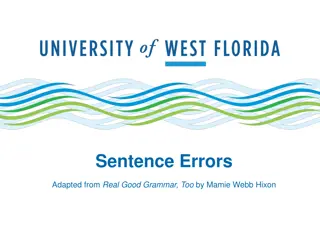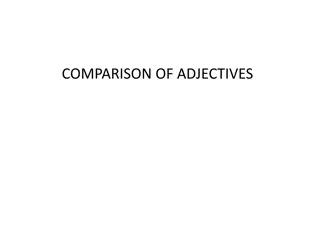Understanding Text Readability Through Sentence Length and Syllable Calculations
Analyzing text readability involves calculations such as sentence length and syllable count to determine the grade level of a text. Methods like the Gunning FOG Readability Test utilize formulas or graphs to provide numerical values representing the text's complexity, which can be converted to reading ages by adding the school starting age in the respective country. The Gunning FOG test includes steps like calculating average sentence length and identifying hard words with more than two syllables. By following these methods, educators can better assess the readability of educational materials.
Download Presentation

Please find below an Image/Link to download the presentation.
The content on the website is provided AS IS for your information and personal use only. It may not be sold, licensed, or shared on other websites without obtaining consent from the author. Download presentation by click this link. If you encounter any issues during the download, it is possible that the publisher has removed the file from their server.
E N D
Presentation Transcript
ASSESSING READABILITY OF A TEXT Through Sentence length &Syllables Number calculations
3. SENTENSE LENGTH & NUMBER OF SYLLABLES CALCULATION FOG FRY GRAPH METHOD THE SMOG FORMULA READABILITY FORMULA
NOTE These two coming methods make use of formula and, or graphs to calculate text readability The formulae gives a numerical value which represents the grade level.
NOTE These grade levels are converted to reading age by adding a school starting age in that country In Tanzanian case, we have to add 7; in America and Europe 5 is the school entrance age for the first graders.
(A).Gunning FOG Readability Test STEPS TO FOLLOW Pick a text of approximately 100 words. Normally 3 such samples. Calculate ASL = Average sentence length Find HW = hard words per sample Calculate Grade level = (ASL + HW) x 0.4
STEP 1: CALCULATING ASL 1. Count out at least 100 words of text in the textbook. This will be the selection you use to determine the readability of the textbook.(Note, having more samples with 100 worlds is recommended) 2. Divide the total number of words in the selection by the total number of sentences in the selection
TOTAL NUMBER OF WORDS ASL = NUMBER OF SENTENSES IN THE SAMPLE
STEP 2: HW Which are hard words? Hard words are assumed to be those which are long (=with more than two syllables)
syllable Refers to a unit of pronunciation having one vowel sound, with or without surrounding consonants, and forming all or part of a word Examples: words another (=3); however (=3); Numbers & symbols 4.2 (3); 1999 (=4) symbol H2O (=3) Abbreviations km, cm, e.g., (@ 2)
STEP 3: GRADE TO READ A BOOK Add average number of hard words (HW) to the average sentence length (ASL) Multiply the ASL plus the HW by 0.4.
STEPS IN SUMMARY cont.. Select samples of 100 words, normally three such samples. Calculate ASL =number of words number of sentences. How to find HW =In each sample, count the number of words with 3 or more syllables. Determine the average value of such words.
WEAKNESSES! it discounts that not all multi-syllabic words are difficult. There must be a common system of pronouncing words
(B). THE FRY READABILITY GRAPH INTRODUCTION Edward Fry developed one of the more popular Reading Formulas the Fry Graph Readability Formula. He worked as a Fulbright Scholar in Uganda, also helped teachers to teach English as a Second Language (ESL) for a few years, from 1963 and onwards
STEPS Step 1: Select 3 samples of 100-word passages randomly Step 2: Count the number of sentences in all three 100-word passages. Use it to calculate average number of sentences (ANS) Step 3: Count the number of syllables in all three 100-word passages. Use it to calculate average number of syllables (ANSY)
Cont Step 4: Enter the graph with average number of Sentence and average number of syllables. Plot dot where the two lines intersect. Area where dot is plotted signifies the approximate reading grade level of the content.
INTERPRETATIONS The curve represents normal texts. Points below the curve imply longer than average sentence lengths. Points above the curve represent text with a more difficult vocabulary (as in school science texts).
For example A passage with around 4 sentences per 100 words and 120 syllables in the same passage will have a reading age of 11 years. A passage with only 3 sentences per 100, and 144 syllables will have a reading age of about 15 years approximately
The SMOG Readability Formula G Harry McLaughlin created the SMOG Readability Formula in 1969 estimates the years of education a person needs to understand a piece of writing SMOG grade = 3 + Square Root of Polysyllable Count
STEPS 1 Count 10 sentences in a row near the beginning, 10 in the middle, and 10 in the end for a total of 30 sentences.
STEP 2 Count every word with three or more syllables in each group of sentences, even if the same word appears more than once. Calculate the average number of such words (AHW)
STEP 3 Calculate the square root of the number arrived at in Step 3 and round it off to nearest 10.
STEP 4 Step 4: Add 3 to the figure arrived at in Step 4 THAT IS THE SMOG Grade, i.e., the reading grade that a person must have reached if he is to understand fully the text assessed Reading Age = [(square root of AHW) +3] + 7 years.
NOTE This test tends to give higher values than the other formulae, because McLaughlin intended it to predict the level necessary for 100% comprehension of the text (whatever that means), whereas other tests were validated against lower comprehension. THUS: SMOG Formula is considered appropriate for secondary age (4th grade to college level) readers
TEACHERS GUIDE A document with pedagogical strategies which helps a teacher to teach more effectively. It also contain details of lesson procedures and answers to questions.
COMPONENTS It is full of Suggestions on: T/L resources, T/L strategies, methodology and tactics, T & L activities, Assessment and evaluation instruments, and supplementary readings.
IMPORTANCE: 1. Provides teachers with a range of alternative suggestions to that shown in the syllabus 2. Helps to update teachers own pedagogical competences 3. Useful to teachers with limited in-service training 4.Suggests a variety of evaluation technique
TEACHERS MANUAL Is a document with systematic stages and steps governing a teacher in experiments and teaching.
IMPORTANCE: 1. Helps teachers to follow the same procedures in evaluation. 2. Useful for pre service teachers. 3. Creates uniformity, safety, and confidence among teachers and students.
AUDIO VISUAL MATERIALS They are the materials with the ability to stimulate both a sense of hearing and seeing. Examples of common used visual materials: Models, Drawn charts, Pictures, Maps, illustrations, etc (WHY) Teachers commonly use them because they are available, simple to design and simple to use
HINTS IN USING AUDIO VISUAL Use only where and when it is a time to do so Make sure it does not obstruct students Make sure it does not bore students Make sure every student can hear and see it.
ADVANTAGE OF INTERACTIVE MEDIA Raise enjoyment Increase students interest Economize learning time Helps in retention of information Motivates learners Provide an alternate to lab experiments
LIMITATION For today s teachers, they are limited by 1. Fund to access technology 2. Knowledge on how to operate 3. Power availability 4. Reliability























